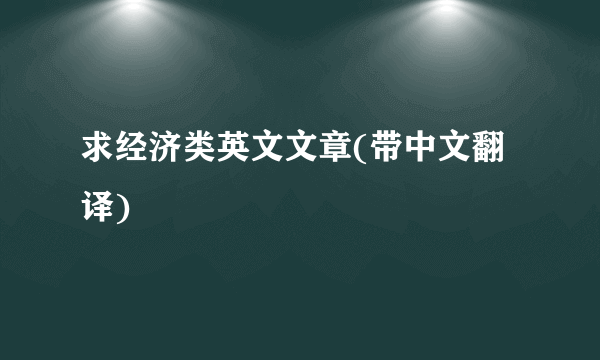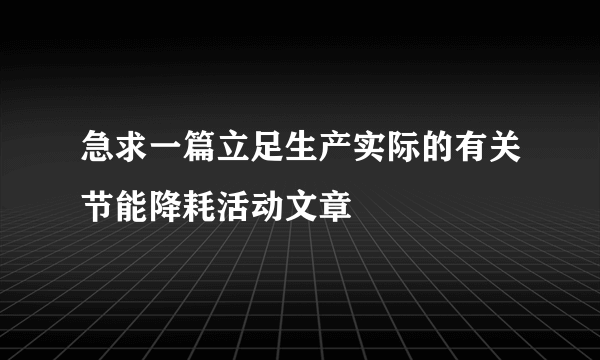求经济类英文文章(带中文翻译)
的有关信息介绍如下:
Macroeconomics is a sub-field of economics that examines the behavior of the economy as a whole, once all of the individual economic decisions of companies and industries have been summed. Economy-wide phenomena considered by macroeconomics include Gross Domestic Product (GDP) and how it is affected by changes in unemployment, national income, rate of growth, and price levels. In contrast, microeconomics is the study of the economic behaviour and decision-making of individual consumers, firms, and industries. Macroeconomics can be used to analyze how to influence government policy goals such as economic growth, price stability, full employment and the attainment of a sustainable balance of payments. Macroeconomics is sometimes used to refer to a general approach to economic reasoning, which includes long term strategies and rational expectations in aggregate behavior. Until the 1930s most economic analysis did not separate out individual economics behavior from aggregate behavior. With the Great Depression of the 1930s, suffered throughout the developed world at the time, and the development of the concept of national income and product statistics, the field of macroeconomics began to expand. Particularly influential were the ideas of John Maynard Keynes, who formulated theories to try to explain the Great Depression. Before that time, comprehensive national accounts, as we know them today, did not exist . One of the challenges of economics has been a struggle to reconcile macroeconomic and microeconomic models. Starting in the 1950s, macroeconomists developed micro-based models of macroeconomic behavior (such as the consumption function). Dutch economist Jan Tinbergen developed the first comprehensive national macroeconomic model, which he first built for the Netherlands and later applied to the United States and the United Kingdom after World War II. The first global macroeconomic model, Wharton Econometric Forecasting Associates LINK project, was initiated by Lawrence Klein and was mentioned in his citation for the Nobel Memorial Prize in Economics in 1980. Theorists such as Robert Lucas Jr suggested (in the 1970s) that at least some traditional Keynesian (after British economist John Maynard Keynes) macroeconomic models were questionable as they were not derived from assumptions about individual behavior, although it was not clear whether the failures were in microeconomic assumptions or in macroeconomic models. However, New Keynesian macroeconomics has generally presented microeconomic models to shore up their macroeconomic theorizing, and some Keynesians have contested the idea that microeconomic foundations are essential, if the model is analytically useful. An analogy might be that the fact that quantum phisics is not fully consistent with relativity theory doesn´t mean that realtivity is false. Many important microeconomic assumptions have never been proved, and some have proved wrong. The various schools of thought are not always in direct competition with one another - even though they sometimes reach differing conclusions. Macroeconomics is an ever evolving area of research. The goal of economic research is not to be "right," but rather to be accurate. It is likely that none of the current schools of economic thought perfectly capture the workings of the economy. They do, however, each contribute a small piece of the overall puzzle. As one learns more about each school of thought, it is possible to combine aspects of each in order to reach an informed synthesis. The traditional distinction is between two different approaches to economics: Keynesian economics, focusing on demand; and supply-side (or neo-classical) economics, focusing on supply. Neither view is typically endorsed to the complete exclusion of the other, but most schools do tend clearly to emphasize one or the other as a theoretical foundation. • Keynesian economics focuses on aggregate demand to explain levels of unemployment and the business cycle. That is, business cycle fluctuations should be reduced through fiscal policy (the government spends more or less depending on the situation) and monetary policy. Early Keynesian macroeconomics was "activist," calling for regular use of policy to stabilize the capitalist economy, while some Keynesians called for the use of incomes policies. • Supply-side economics delineates quite clearly the roles of monetary policy and fiscal policy. The focus for monetary policy should be purely on the price of money as determined by the supply of money and the demand for money. It advocates a monetary policy that directly targets the value of money and does not target interest rates at all. Typically the value of money is measured by reference to gold or some other reference. The focus of fiscal policy is to raise revenue for worthy government investments with a clear recognition of the impact that taxation has on domestic trade. It places heavy emphasis on Say's law, which states that recessions do not occur because of failure in demand or lack of money. • Monetarism, led by Milton Friedman, which holds that inflation is always and everywhere a monetary phenomenon. It rejects fiscal policy because it leads to "crowding out" of the private sector. Further, it does not wish to combat inflation or deflation by means of active demand management as in Keynesian economics, but by means of monetary policy rules, such as keeping the rate of growth of the money supply constant over time. • New Keynesian economics, which developed partly in response to new classical economics, strives to provide microeconomic foundations to Keynesian economics by showing how imperfect markets can justify demand management. • Austrian economics is a laissez-faire school of macroeconomics. It focuses on the business cycle that arises from government or central-bank interference that leads to deviations from the natural rate of interest. • Post-Keynesian economics represents a dissent from mainstream Keynesian economics, emphasizing the role of uncertainty and the historical process in macroeconomics. • New classical economics. The original theoretical impetus was the charge that Keynesian economics lacks microeconomic foundations -- i.e. its assertions are not founded in basic economic theory. This school emerged during the 1970s. This school asserts that it does not make sense to claim that the economy at any time might be "out-of-equilibrium". Fluctuations in aggregate variables follow from the individuals in the society continuously re-optimizing as new information on the state of the world is revealed. Later yielded an explicit school which argued that macro-economics does not have micro-economic foundations, but is instead the tool of studying economic systems at equilibrium. 宏观经济学是一种分场经济学的行为,研究是在整个经济中,一旦所有的个人的经济决策,为公司和产业被。宏观经济学认为经济现象包括国内生产总值(GDP)以及它是如何变化影响失业的国民收入的)经济成长率、价格水平。相反,微观经济学研究的就是经济行为和决策的个体消费者,公司和行业。宏观经济学可以用来分析如何影响政府的政策的目标,比如经济增长,价格稳定,充分就业和获取可持续国际收支差额。宏观经济学有时用来指一个经济理论的主要途径,包括长期战略的期望和理性综合行为。直到30年代为止,大部分的经济分析没有独立的个人经济综合行为举止。与1930年代的经济大萧条,遭受了在所有发达国家,发展国民收入的概念和产品的统计数据,但是研究领域的宏观经济学开始扩展。具有特殊影响力的想法是,约翰•梅纳德凯恩斯理论,努力向他们解释制定了经济大萧条。在那时候,综合国民经济核算,如同我们知道他们今天,是不存在的。经济学的一个挑战是一场斗争调和宏观经济政策和微观经济政策,模型。开始于20世纪50年代,macroeconomists发达micro-based模型的宏观经济行为(如消费函数)。1月Tinbergen荷兰经济学家第一个全面发展国家宏观经济模型,该模型他第一次建成为荷兰和后应用于美国和英国二战之后。第一个全球宏观经济模型,沃顿计量预测伙伴联系工程项目,发生在劳伦斯发起克莱恩和被提及他的嘉奖经济学诺贝尔经济学奖1980年。理论家如罗伯特·卢卡斯认为(是在上世纪70年代),认为至少有一些传统的凯恩斯(英国经济学家约翰梅纳德凯恩斯)宏观经济模型都是可疑的,因为他们不是来源于假设的个人行为,虽然现在还不清楚这些失败在微观经济的假定,或是对宏观经济模型。然而,最新凯恩斯主义的宏观微观模型提出了大致以支持他们的宏观经济理论有争议,一些凯恩斯主义者的想法,微观经济基础是必要的,如果模型是分析有用的。打个比方可能是,这样的事实,即量子phisics并不完全符合相对论´,并不代表没有realtivity是假的。许多重要的微观经济假设从来没有被证明,而有些人的证明是错误的。各种各样的思想学派并不总是在彼此的直接竞争,尽管他们有时会达到不同的结论。宏观经济学是一种前所未有的领域的研究。研究经济学的目标不是"正确",而是是精确的。很有可能是学校目前尚无一个经济思想完全捕捉运作方式的经济。不过,他们的贡献每一小块整体难题。当你学会更多关于每个思想学派,它能把方面的每一个为了达到一个通知的合成。传统的区别是留给经济学两种不同的方法,重点凯恩斯经济学和供方需求;(或古典)经济学、关注供应。也都是典型的观点完全排除其他,但大多数学校都往往清晰地强调一个或另一个是的理论基础。•凯恩斯经济学交融在总需求,以解释失业率和商业周期。商业周期波动,应减少通过财政政策(政府花费或多或少根据实际情况)和货币政策。早期凯恩斯主义的宏观经济学是“活动家,定期使用《召唤的政策稳定资本主义经济,虽然有些凯恩斯主义要求使用收入政策。•供给的经济学的作用很明显地在当前货币政策与财政政策。关注于货币政策应该是完全对价格的钱所确定的货币供应的需求的特点,为了金钱。它提倡货币政策,直接目标钱的价值,不目标利率。典型的钱的价值在于用参考金或其他参考。财政政策的重点是提高政府农业投资价值的收入为一个明确的认识税收的影响在国内贸易。它设置了过度强调了说的法律,它表明不会发生经济衰退需求下降、因为没有缺钱。•货币主义的带领下,由弗里德曼,认为始终通货膨胀是一种货币现象。财政政策拒绝,因为会导致“挤退”的私人生活。此外,它不希望对抗通货膨胀或通货紧缩采用主动需求管理在凯恩斯经济学,通过货币政策规则,即坚持的增长速度恒定的钱。凯恩斯•新经济发达的部分原因是为了适应新古典经济学、致力于提供凯恩斯现代经济学的微观经济基础显示出了市场的不完善就能名正言顺的需求管理等。•奥地利经济学是个自由放任主义的学校的宏观经济。它侧重于商业周期,而政府或中央银行的干扰导致偏离自然失业率的兴趣。•Post-Keynesian经济学所代表了凯恩斯经济学主流的作用,强调历史过程中不确定性和宏观经济。•新古典经济学。原理论动力的费用是凯恩斯经济学缺乏有效的微观经济基础——亦即其断言不成立于基本经济理论。这所学校出现在20世纪70年代。这所学校断言它是没有道理的主张经济会随时out-of-equilibrium”。波动的总变量遵从的在这个社会的个人不断re-optimizing新信息的状态的世界就会显现出来。后来取得了一个显式学校一样,认为宏观经济学没有微观经济基础,反而学习经济系统的工具在平衡。



